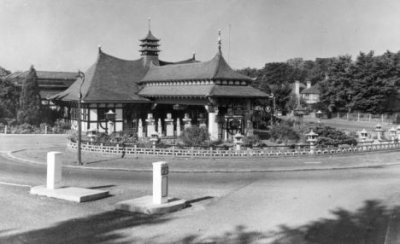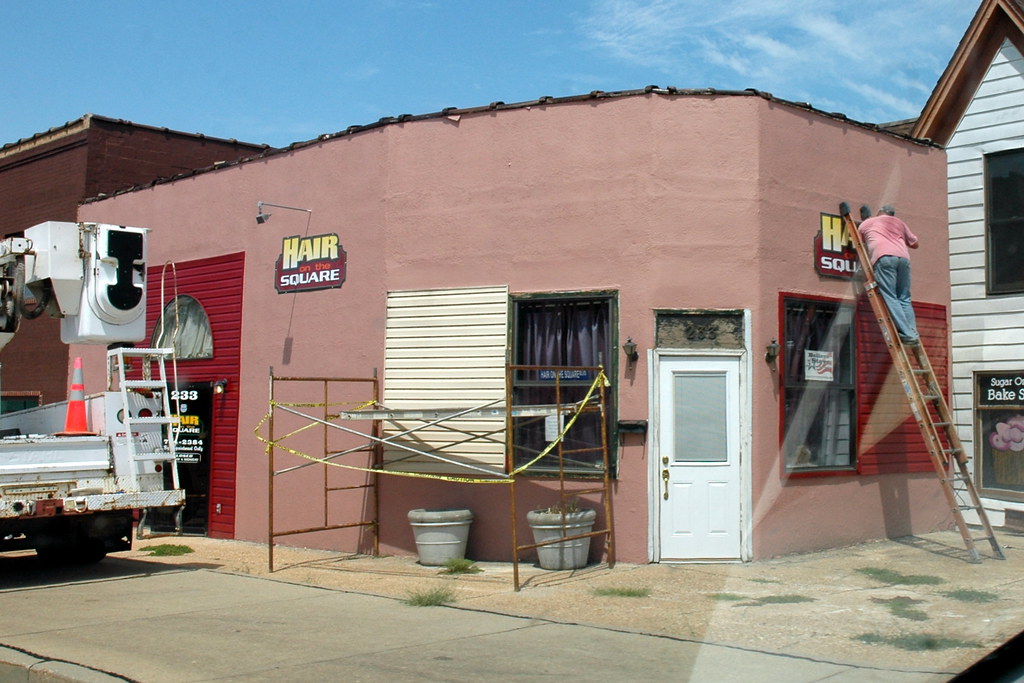- Messages
- 17,483
- Location
- New York City
⇧ I'm no car guy, but that looks like a very late '40s Lincoln to me (script on side made the Lincoln part easy).
The license plate appears either not to be there at all, or is blacked out to prevent it from being identified. The red thing is possibly a fire department plate topper, attached to the bottom plate mounting bolts -- many small-town fire departments issued these toppers, which were usually either red with white lettering or white with red lettering, in order to ensure that the vehicles owned by members could get emergency parking without being towed or ticketed. The top row of lettering is probably the name of the town, while the bottom row might say "FIRE DEPT."
The station is a generic concrete block building remodeled into the Teague Texaco format -- probably a paint lease.
The license plate appears either not to be there at all, or is blacked out to prevent it from being identified. The red thing is possibly a fire department plate topper, attached to the bottom plate mounting bolts -- many small-town fire departments issued these toppers, which were usually either red with white lettering or white with red lettering, in order to ensure that the vehicles owned by members could get emergency parking without being towed or ticketed. The top row of lettering is probably the name of the town, while the bottom row might say "FIRE DEPT."
The station is a generic concrete block building remodeled into the Teague Texaco format -- probably a paint lease.
The Esso-Exxon situation stems from the consent decree which broke up the Standard Oil Company in 1911. Each of the "Baby Standards" was given the right to use the Standard Oil trademark in a specific geographical area in the US, and Standard of New Jersey was confined to the Eastern Seaboard as well as Louisiana, Arkansas and Tennessee. They began using the Esso trademark -- a phonetic rendering of S. O. for Standard Oil -- in hopes that it would circumvent this restriction, but when it tried to move into the territory of other Standard companies it was usually sued, the only real exception being New England-New York, where they snuck past Socony long enough to get established.
Standard of New Jersey wanted to become a national marketer along the lines of Gulf and Texaco, but it was hamstrung every step of the way by the trademark issue, and ended up selling in states outside its territory under a variety of alternative trademarks with Humble and Enco being the most prominent. Finally in the early 70s they came up with "Exxon" as a trademark acceptable in all fifty states and began using it in late 1972 with a big splashy ad campaign featuring the Esso Tiger declaring "We've changed out name -- but not our stripes!"

Since they weren't bound by the consent decree anywhere else in the world, though, they kept using Esso everywhere else. A couple years back a court ruling declared that enough time has passed that their use of Esso in the US wouldn't cause confusion in the marketplace, so technically they're free to use it again. But Exxon no longer markets in all fifty states, and there hasn't been any movement to change the logo back to Esso in those where it does.
 John Lofgren Monkey Boots Shinki Horsebuttt - $1,136 The classic monkey boot silhouette in an incredibly rich Shinki russet horse leather.
John Lofgren Monkey Boots Shinki Horsebuttt - $1,136 The classic monkey boot silhouette in an incredibly rich Shinki russet horse leather.  Grant Stone Diesel Boot Dark Olive Chromexcel - $395 Goodyear welted, Horween Chromexcel, classic good looks.
Grant Stone Diesel Boot Dark Olive Chromexcel - $395 Goodyear welted, Horween Chromexcel, classic good looks.  Schott 568 Vandals Jacket - $1,250 The classic Perfecto motorcycle jacket, in a very special limited-edition Schott double rider style.
Schott 568 Vandals Jacket - $1,250 The classic Perfecto motorcycle jacket, in a very special limited-edition Schott double rider style. Re the above discussion: growing up on the '60s and '70s the brand of gas seemed important to many (we shopped mainly on price, but even so, we avoided a few brands - but were mainly price driven), but it doesn't seem that way anymore as most people today buy their gas based on convenience and price not brand. What happened - did people get wise or did the brands (the oil companies) find that investing in their brand / advertising wasn't paying off?
The best of the "We're Changing Our Name" commercials, which ran on local stations in the fall of 1972. Because of the different brands being eliminated, there were multiple soundtracks mentioning the "Esso Tiger," the "Enco Tiger," and the "Humble Tiger," but the same animation was used for each version. This is the "Humble Tiger" version, which ran in Ohio -- where Sohio refused to allow anything even remotely close to "Esso."



Is Joe's car a Packard?
Is Joe's car a Packard?
This photo of Member of Parliament, Tom Williams, shows that there was self service back in the day. This photo is dated 1935. Note the name of the fuel. Coalene, was a petroleum product produced from coal.
View attachment 85045
